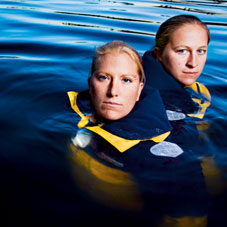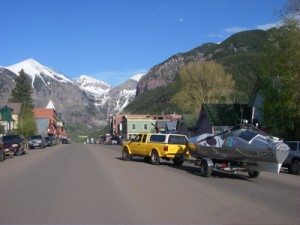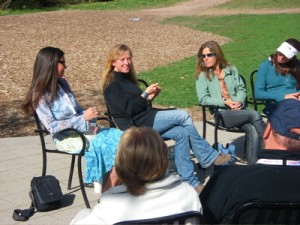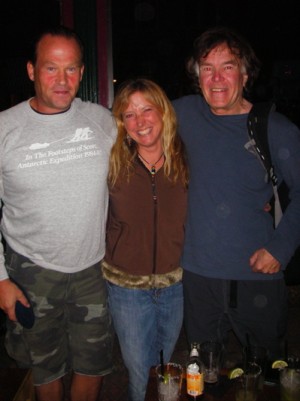
In La Gomera last year the girls of American Fire, Sarah Kessans and Emily Kohl, became famous for their smiles. No matter what was going on, they were always grinning.
(I have no idea how the photographer of the sultry shot above managed to get them to turn off their usual canteloupe grins.)
But they probably weren't grinning on the night of January 14th, 2006, when their boat capsized and failed to self-right, and they spent 16 hours waiting for help. (Click here to read the story in May's Reader's Digest.)
I saw the footage of their dramatic rescue for the first time when I was at Mountainfilm last weekend. Later that night I woke up in the wee small hours, my mind full of images of myself clinging to Sedna's upturned hull in the middle of the Pacific, while sharks circled...
In the morning my thoughts had taken a more practical turn - I'm determined to avoid the need for rescue. So as I enter the final stage of preparations for the Pacific, ocean safety is top of my list of priorities.
P.S. I emailed Sarah and Emily to get the definitive version of what happened, as reports at the time mistakenly implied that they had left their main hatches open. Here are their comments:
"NONE of our hatches were open! The water came in through our two ventilating fans. We had a total of three of them onboard: two on our front bulkhead and one inserted into our aft hatch (the one near the rudder). We had rubber inserts that fit into them and locked when we wanted them to be completely watertight. Since we had been in the cabin for about 18 hours, we needed some ventilation, and took the rubber inserts out of the two bulkhead vents to let some air in. If a wave hit them, it was not problem as their design kept the water out, but inverted was another story, and water rushed in them and the rest is history :(.
Our ventilating fans did not initally have the rubber inserts, but Tom and John (who had the boat before us) suggested that we buy rubber PVC pipe stops. The stops fit exactly in a piece of PVC that they had fixed to the inside of our vents. They kept the water completely out of the cabin when they were in (we had lots of waves over the stern of the boat, and we never had any problems whatsoever with the back fan). Since the PVC pipe/rubber stop was sort of a homemade thing and didn't help us in the end (since we didn't have a lanyard on the stops, they simply became part of the soup in the cabin when we capsized), I would suggest getting fans that have stops built into them.
As far as our liferaft... that's a story in itself as well. We got sponsorship from a company and for the most part they were great, letting us use a liferaft for free. The only problem was that the one they gave us was in a hard case instead of a valise. The hard case took up the majority of our footwell, and was basically a pain in the backside the entire time. We had thoughts of throwing it overboard, but kept it onboard since we knew that if there came a time that we needed it, we'd be happy to have it. So it stayed in the footwell, tied on by a rope, some velcro, and its painter line. When we capsized, the wave was so violent that basically anything that was not in a hatch or in the cabin was washed away, whether it was tethered or not. (Fortunately, our lifejackets and harnesses got tangled up in our emergency grab line and stayed with the boat. So, as we were waiting for the cabin to fill up so we could open a hatch, I watched the liferaft float away. By the time we got out, the raft was long gone (but of course, an untethered bucket and a Santa hat stayed close to us the entire 16 hours). My suggestion is to NEVER go out to sea with a hard case liferaft. They're hard to tie up (as opposed to a valise), big, and don't help you when you need it the most.
Sarah and Emily
|
|

And my kind of festival. Mountainfilm 2007 has been very enjoyable and very thought-provoking. It's given me ideas for a number of new projects, and a huge boost to my confidence as a public speaker.
As Arnie said, I'll be back...
[photo by Eric Sanford: Quackers and Sedna in Main Street, Telluride]
|
|

A final presentation - the Adventure Divas (and me) taking Q&A from an outdoor crowd in Telluride. From left to right: Bernice Notenboom (skiing to 3 poles this year), me, Lynn Hill (legendary climber) and Kit DesLauriers (first person to ski from the top of the Seven Summits).
Maybe the most amusing question was from a man organizing a mixed-sex expedition, who asked: "Men on expedition apparently think mostly about food, sex and poo. What do women think about, and what women-specific factors do I need to take into account?"
The obvious retort is, "So what makes those 'men on expedition' different from men in any other walk of life?"
[photo: Eric Sanford]
|
|

Last night I gave my presentation at the Sheridan Opera House in Telluride - a beautiful old theatre on the Main Street. I'd written a special presentation for the occasion, and it seemed to go down rather well. In fact, they gave me a standing ovation. Which was very generous of them.
Afterwards I went for a post-presentation beer with a couple of polar legends - Will Steger (US), and fellow Brit Sir Robert Swan. (Will on the right of the photo, Sir Rob on the left.)
Mountainfilm has been a fantastic experience - as well as some deeply thought-provoking films and presentations, it has given me the chance to meet some people on the leading edge of exploration and environmentalism.
Oops, must run. One final presentation - I'm due to take part in a breakfast discussion with three other women, including climbing legend Lynn Hill. Best not be late.
[photo: Eric Sanford]
|
|